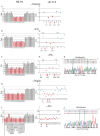Alpha-Thalassemia in Southern Italy: Characterization of Five New Deletions Removing the Alpha-Globin Gene Cluster
- PMID: 36768900
- PMCID: PMC9916800
- DOI: 10.3390/ijms24032577
Alpha-Thalassemia in Southern Italy: Characterization of Five New Deletions Removing the Alpha-Globin Gene Cluster
Abstract
α-thalassemia is characterized in about 80% of cases by deletions generated by the presence of duplications and interspersed repeated sequences in the α-globin gene cluster. In a project on the molecular basis of α-thalassemia in Southern Italy, we identified six families, showing an absence of the most common deletions, and normal α-globin gene sequences. Multiplex Ligation-dependent Probe Amplification (MLPA), qRT-PCR, and the sequencing of long-range PCR amplicon have been used for the identification and characterization of new deletions. MLPA analysis for the identification of α- and β-globin rearrangement revealed the presence of five new α-thalassemia deletions. The set-up of qRT-PCR allowed us to delimit the extent of the deletions ranging from about 10 kb to more than 250 kb, two of them being of the telomeric type. The long-range PCR generated a specific anomalous fragment in three deletions, and only several unspecific bands in the other two deletions. The sequencing of the anomalous amplicons revealed the breakpoints of two deletions: the --PA, 34 kb long, identified in two families, and the telomeric --AG, 274 kb long. The anomalous fragment containing the breakpoint of the deletion --FG was partially sequenced, and it was not possible to identify the breakpoints due to the presence of several repetitive Alu sequences. The analysis of the breakpoint regions of the --Sciacca and --Puglia, respectively, are about 10 and 165 kb long, and revealed the presence of repeats that most likely impaired the amplification of a specific fragment for the identification of the breakpoint. MLPA, in association with qRT-PCR and long-range PCR, is a good approach for the identification and molecular characterization of rare or new deletions. Breakpoint analysis confirms that Alu sequences play an important role in favoring unequal crossing-over. Southern Italy shows considerable genetic heterogeneity, as expected with its central position in the Mediterranean basin, favoring migratory flows.
Keywords: --AG; --FG; --PA; --Puglia; --Sciacca; MLPA; alpha-thalassemia; deletion breakpoint characterization; qRT-PCR.
Conflict of interest statement
The authors declare no conflict of interest.
Figures



Similar articles
-
Identification of a novel 107 kb deletion in the alpha-globin gene cluster using third-generation sequencing.Clin Biochem. 2023 Mar;113:36-39. doi: 10.1016/j.clinbiochem.2022.12.010. Epub 2022 Dec 23. Clin Biochem. 2023. PMID: 36572139
-
Development and clinical implementation of a combination deletion PCR and multiplex ligation-dependent probe amplification assay for detecting deletions involving the human α-globin gene cluster.J Mol Diagn. 2011 Sep;13(5):549-57. doi: 10.1016/j.jmoldx.2011.04.001. Epub 2011 Jun 25. J Mol Diagn. 2011. PMID: 21708285 Free PMC article.
-
Identification and molecular characterization of a novel 163 kb deletion: The Italian (ϵγδβ)(0)-thalassemia.Hematology. 2016 Jun;21(5):317-24. doi: 10.1080/10245332.2015.1133007. Epub 2016 Feb 24. Hematology. 2016. PMID: 27077761
-
Investigation of the mechanism of copy number variations involving the α-globin gene cluster on chromosome 16: two case reports and literature review.Mol Genet Genomics. 2023 Jan;298(1):131-141. doi: 10.1007/s00438-022-01968-1. Epub 2022 Nov 3. Mol Genet Genomics. 2023. PMID: 36326959 Review.
-
Alpha-thalassaemia.Baillieres Clin Haematol. 1998 Mar;11(1):53-90. doi: 10.1016/s0950-3536(98)80070-x. Baillieres Clin Haematol. 1998. PMID: 10872473 Review.
Cited by
-
Functional analysis of three new alpha-thalassemia deletions involving MCS-R2 reveals the presence of an additional enhancer element in the 5' boundary region.PLoS Genet. 2023 May 22;19(5):e1010727. doi: 10.1371/journal.pgen.1010727. eCollection 2023 May. PLoS Genet. 2023. PMID: 37216374 Free PMC article.
References
-
- Harteveld C.L., Voskamp A., Phylipsen M., Akkermans N., den Dunnen J.T., White S.J., Giordano P.C. Nine unknown rearrangements in 16p13.3 and 11p15.4 causing alpha- and beta-thalassaemia characterised by high resolution multiplex ligation-dependent probe amplification. J. Med. Genet. 2005;42:922–931. doi: 10.1136/jmg.2005.033597. - DOI - PMC - PubMed
MeSH terms
Substances
Grants and funding
LinkOut - more resources
Full Text Sources

